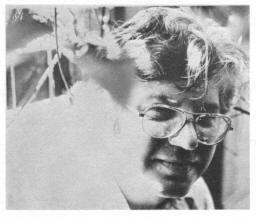JG 99 - IN THIS ISSUE
JG 99 - IN THIS ISSUE
This issue includes several essays about art and aesthetics.
Raimonds Staprāns (San Francisco) analyzes the creative process involved in a serigraph by Ivars Hiršs. Hiršs' work begins with choice of the primary color on which others are superimposed according to design and color scheme; his work also incorporates, as an integral part, old Latvian decorative symbols and ornaments. The article is also an analysis of the stark simplification and strength of contemporary art. Laimonis Mieriņš discusses the problem of whether or not art should serve some specific ideology or exist per se - a question that concerns artists under democratic as well as totalitarian governments. Extreme examples of art subservient to some cause can be found in the West in advertising art and political campaigns, in the East, in socialist realism. Among Latvians in exile, one finds a penchant for excessive use of nostalgic images. Mieriņš concludes that any kind of ideological propaganda is narrow-minded and stifles creative impulses; art should stand above it.
Uldis Bergs dissects the various psychological pressures involved in change of one's cultural environment. Bergs argues that excessive dependence on environment can often lead to a sense of dissociation, emptiness, and apathy. Those capable of resolving their own conflicts, however, can also assimiliate various cultures to their personal mental enrichment.
Lūcija Bērziņa's essay on Patrick White, recipient of 1973 Nobel Prize for Literature, brings out the irony of White's having won acclaim abroad, but not in his native Australia. Some critics have compared White's complex, myth-permeated novels to Dostoevsky's; others have decried his emphasis on human evil, lack of human motivation, and negative portrayal of Australian life. Bērziņa analyzes the problem of loneliness in White's novel The Tree of Life, man's symbolic journey through darkness in Voss, and describes the central problem of his later novels as the question - what are the forces that move the human spirit toward freedom and purification - or toward spiritual annihilation?
Islandic prose-writer Svava Jakobsdottir's story "Mother of Children" (translated from English by Ilze Šķipsna) almost becomes propaganda for women's liberation in its vivid portrayal of the horrors of a woman's enslavement to home and children. The symbolism is a bit heavy-handed - the children first cut off her toe, then saw her head open and place her brains in a j ar - to all of which she humbly acquiesces. Finally they turn in revulsion from the bleeding, oversized heart she offers them. The style is, nevertheless, surrealistically effective.
The literature section also includes Eduards Freimanis' short verse play, "The Expatriation of the Semgallians", which utilizes the folk song idiom, and poems by Irma Bērzina, Ontons Zvīdris, Guna Ikona, Herta Krauja, Laine Alksne, Ints Liepa, and Juris Kronbergs, which illustrate a variety of themes and styles. Of special interest is Kronbergs' wry, ironic commentary on ars poetica.
Uldis Ģērmanis' monograph The Commander from Zemgale, which analized the role Colonel Jukums Vācietis played in the successful Soviet revolution, was published in issues 76-90 of Jaunā Gaita. So far, no reviews have appeared in the Latvian press, perhaps because of widespread (and understandable) unwillingness to admit some of the facts documented by Ģērmanis. This issue includes 2 reviews - by Dr. Jürgen von Hehn, a Baltic-German historian, and by Pēteris Dardzāns, who as an officer whitnessed numerous events described in the monograph.
Included in the regular sections of Jaunā Gaita is Gunars Irbe's review of the special issue of Books Abroad, devoted to Baltic letters today and University of Manitoba's Mosaic, devoted to Eastern European imagination in literature.
The cover is by Alberts Vasils, the frontispiece by Ivars Hiršs.
I. Š.-L.

Ivars Hiršs, who is featured in the art section, is one of several Latvian-born artists now living in the San Francisco area.